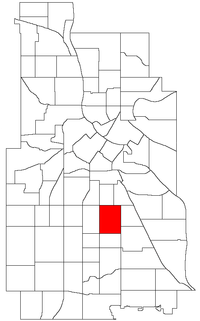Loading AI tools
Neighborhood in Hennepin, Minnesota, United States From Wikipedia, the free encyclopedia
Powderhorn Park is a neighborhood within the larger Powderhorn community of Minneapolis. The neighborhood is located approximately three miles south of downtown and is bordered by East Lake Street to the north, Cedar Avenue to the east, East 38th Street to the south, and Chicago Avenue to the west. Its namesake is the city's Powderhorn Park facility in the northwestern part of the neighborhood around Powderhorn Lake.
Powderhorn Park | |
|---|---|
 Location of Powderhorn Park within the U.S. city of Minneapolis | |
| Coordinates: 44°56′23″N 93°15′12″W | |
| Country | United States |
| State | Minnesota |
| County | Hennepin |
| City | Minneapolis |
| Community | Powderhorn |
| Founded | 1849 |
| City Council Ward | 9 |
| Government | |
| • Council Member | Jason Chavez |
| Area | |
| • Total | 0.731 sq mi (1.89 km2) |
| Population (2020)[2] | |
| • Total | 8,440 |
| • Density | 12,000/sq mi (4,500/km2) |
| Time zone | UTC-6 (CST) |
| • Summer (DST) | UTC-5 (CDT) |
| ZIP code | 55407 |
| Area code | 612 |
Developed mainly between 1905 and 1920, it is a residential area consisting of single-family homes, duplexes, and three-story brick apartment buildings.
The neighborhood is in Minneapolis City Council Ward 9, currently represented by Jason Chavez.[3]
In 2009, a group of residents started the Powderhorn365 program that documents the day-to-day life of the neighborhood, through a daily photograph from the neighborhood.
On May 25, 2020, the neighborhood was the site of the murder of George Floyd.[4] In response, residents of the neighborhood have vowed not to call the police; "doing so, they believed, would add to the pain that black residents of Minneapolis were feeling and could put them in danger."[5] Protesters converted the 38th and Chicago intersection into George Floyd Square, an occupation protest and memorial site for George Floyd that persisted into 2021.
Approximately 8,500 people live in Powderhorn Park, down from about 9,000 in 2000. Since 2000, the proportion of residents who are non-Hispanic whites has increased to nearly 50%.[6] Hispanic or Latinos of any race are 30% of the population. Along Lake Street, there are numerous Hispanic and African-American-owned businesses. Around 28% of residents speak a language other than English at home, and 16% are foreign-born residents.[7]
| Race/ethnicity | ||||||
|---|---|---|---|---|---|---|
| 2000[6] | 2010[6] | 2020[6] | ||||
| Number | % | Number | % | Number | % | |
| White alone | 3,735 | 41.7 | 3,822 | 44.2 | 3,911 | 46.3 |
| Black alone | 1,945 | 21.7 | 1,198 | 13.8 | 1,119 | 13.3 |
| Hispanic or Latino (any race) | 1,971 | 22.0 | 2,784 | 32.2 | 2,485 | 29.6 |
| Native American alone | 442 | 4.9 | 267 | 3.1 | 117 | 1.4 |
| Asian alone | 430 | 4.8 | 205 | 2.4 | 177 | 2.1 |
| Pacific Islander alone | 9 | 0.1 | 2 | 0.0 | 6 | 0.1 |
| Other race alone | 36 | 0.4 | 33 | 0.4 | 46 | 0.6 |
| Two or more races | 389 | 4.3 | 344 | 4.0 | 539 | 6.4 |
| Total | 8,957 | 100.0 | 8,655 | 100.0 | 8,440 | 100.0 |

The Powderhorn Park neighborhood is named for the park in its center, run by the Minneapolis Park and Recreation Board. The name Powderhorn initially comes from Powderhorn Lake, which was curved in a powder horn shape until the mid-1920s, when its northern arm was filled.[8] The park and lake are used as the setting for the last act in the city's annual May Day parade.
An encampment for people experiencing homelessness emerged at the park in mid-2020 as a result of civil disorder in the aftermath of George Floyd's murder. The Powderhorn Park encampment was considered the largest in the history of the Twin Cities metropolitan history.[5][9]
Seamless Wikipedia browsing. On steroids.
Every time you click a link to Wikipedia, Wiktionary or Wikiquote in your browser's search results, it will show the modern Wikiwand interface.
Wikiwand extension is a five stars, simple, with minimum permission required to keep your browsing private, safe and transparent.